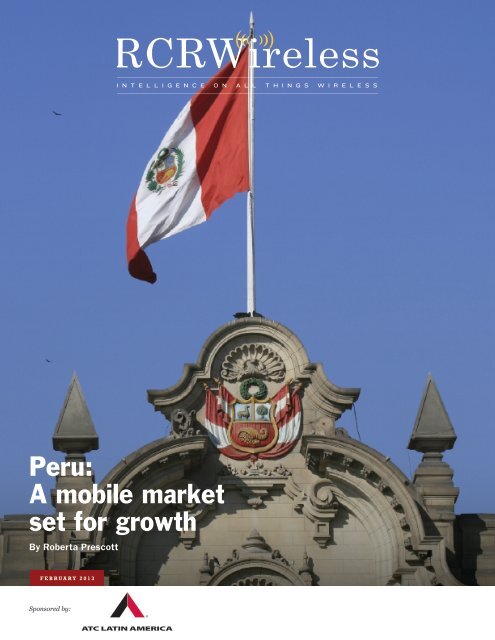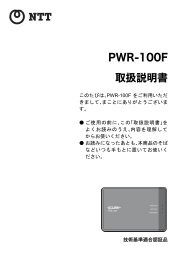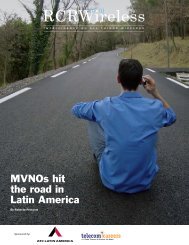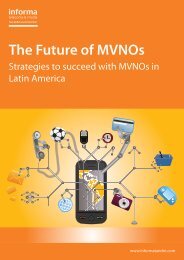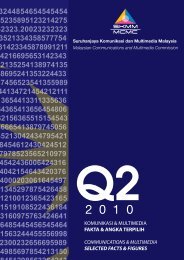Peru: A mobile market set for growth - Prepaid MVNO
Peru: A mobile market set for growth - Prepaid MVNO
Peru: A mobile market set for growth - Prepaid MVNO
You also want an ePaper? Increase the reach of your titles
YUMPU automatically turns print PDFs into web optimized ePapers that Google loves.
<strong>Peru</strong>:<br />
A <strong>mobile</strong> <strong>market</strong><br />
<strong>set</strong> <strong>for</strong> <strong>growth</strong><br />
By Roberta Prescott<br />
FEBRUARY 2013<br />
Sponsored by:<br />
ATC LATIN AMERICA
FEATURE REPORT<br />
<strong>Peru</strong>’s wireless <strong>market</strong> – dominated by Movistar and Claro – may<br />
not be the most dynamic, but it may present new opportunities as the<br />
country works to increase broadband penetration, expand 3G services<br />
and data consumption.<br />
Dominated by the two largest Latin<br />
American telecom operators, <strong>Peru</strong>’s<br />
wireless <strong>market</strong> still holds promise. As<br />
observers have noted, there is room to<br />
grow in <strong>Peru</strong> as <strong>mobile</strong> penetration is at<br />
96%, 2G services accounts <strong>for</strong> 91% of the<br />
total <strong>market</strong> and 76% of <strong>mobile</strong> lines are<br />
via prepaid. Evolving technologies and<br />
more carrier competition are potential<br />
drivers of new opportunities.<br />
Analysts noted that while <strong>Peru</strong> is currently<br />
home to three established carriers<br />
– Telefónica’s Movistar, América Móvil’s<br />
Claro and NII Holdings’ Nextel – the<br />
country lacks the depth of competition of<br />
some <strong>market</strong>s such as Brazil.<br />
“Two operators pretty much hold the<br />
<strong>market</strong>, and the operators are in a very<br />
com<strong>for</strong>table competitive position. It is<br />
not a dynamic <strong>market</strong>, nor is there high<br />
competition,” said Daniele Tricarico, analyst<br />
at Pyramid Research.<br />
More activity is expected in the future.<br />
In the <strong>mobile</strong> space, Vietnamese <strong>mobile</strong><br />
network operator Viettel Group recently<br />
was awarded spectrum licenses and announced<br />
the launch of technical operations<br />
and trial services. Some niche companies<br />
have also entered the <strong>market</strong>, such<br />
as Olo, which is offering <strong>mobile</strong> Internet<br />
services using WiMAX technology.<br />
Despite the challenges, Tricarico noted<br />
<strong>Peru</strong> is a <strong>growth</strong> <strong>market</strong> and is far from<br />
saturated. <strong>Peru</strong> has also been going<br />
through a period of robust economic<br />
<strong>growth</strong>, which should spell opportunity<br />
<strong>for</strong> the <strong>mobile</strong> space.<br />
“There are opportunities <strong>for</strong> data services,<br />
<strong>for</strong> both fixed and <strong>mobile</strong> broadband<br />
providers mostly in the corporate<br />
segment, and there are good opportunities<br />
<strong>for</strong> <strong>mobile</strong> providers to offer broadband,<br />
even Wi-Fi,” Tricarico said.<br />
Although some analysts count <strong>Peru</strong>’s<br />
<strong>mobile</strong> lines at 29 million, the latest official<br />
data from <strong>Peru</strong>’s regulatory agency,<br />
Osiptel, states that the country had<br />
just over 34 million wireless customers<br />
in mid-2012. Of those, Movistar counted<br />
<strong>Peru</strong> snapshot<br />
Mobile telephony penetration: 96%<br />
2G : 91% of total connections<br />
3G: 4% of total connections<br />
<strong>Prepaid</strong>: 76% of total connections<br />
Postpaid: 24% of total connections<br />
Carrier <strong>market</strong> share:<br />
Movistar: 51.5%<br />
Claro: 43.2%<br />
Nextel: 5.3%<br />
Source: In<strong>for</strong>ma Telecoms & Media/Q312<br />
20.8 million customers, Claro served 11.9<br />
million subscribers and Nextel’s customer<br />
base numbered just over 1.3 million.<br />
According to an In<strong>for</strong>ma Telecoms &<br />
Media report, Movistar led the <strong>Peru</strong>vian<br />
telecom <strong>market</strong> with a 51.5% <strong>market</strong><br />
share in the third quarter of 2012. Claro<br />
followed with 43.2% of the <strong>market</strong> and<br />
Nextel with 5.3%.<br />
Although still leading, Movistar has<br />
lost some of its <strong>market</strong> share. In 2010,<br />
Telefónica’s unit in <strong>Peru</strong> controlled<br />
about 54% of the <strong>market</strong>, with Claro<br />
having grown its share from 41% in<br />
2010. Nextel’s share of the <strong>market</strong> has<br />
remained stable.<br />
Elia San Miguel, principal analyst with<br />
Gartner Research, believes that Movistar<br />
will keep its leadership and make more<br />
aggressive moves following the unification<br />
of its fixed and <strong>mobile</strong> operations.<br />
“<strong>Peru</strong> is a very concentrated <strong>market</strong>, with<br />
Movistar and Claro leading not only in <strong>mobile</strong><br />
lines but also in fixed telephony and<br />
pay-TV services,” said Sebastián Menutti,<br />
analyst at Signals Telecom Consulting.<br />
Although Nextel is a niche player focused<br />
on the corporate <strong>market</strong>, by deploying<br />
its 3G network, the carrier is<br />
expanding its reach, noted Menutti. He<br />
also highlighted that Nextel’s average<br />
revenue per user is almost double that of<br />
Movistar and Claro.
FEATURE REPORT<br />
“These technologies allow corporations<br />
to jump into unified communication solutions,”<br />
he said.<br />
<strong>Peru</strong>’s <strong>mobile</strong> penetration is near saturation, though only a small fraction use advanced devices.<br />
Source: Osiptel<br />
In <strong>Peru</strong>, growing ARPU is a challenge, structure required to support telecommunications<br />
<strong>growth</strong> is one of the mar-<br />
with current ARPU of $9 per month,<br />
which is one of the lowest in the region. kets main investment areas.<br />
“Generally, <strong>Peru</strong>’s wireless <strong>market</strong> In addition, La Rosa said that corporate<br />
adoption of in<strong>for</strong>mation and commu-<br />
has been growing, but there’s still more<br />
room to grow,” said Carlo Dávila La nications technology is also increasing,<br />
Rosa, telecommunications analyst at and enterprises will need to invest in<br />
IDC <strong>Peru</strong>. La Rosa noted that infra- networking, switching and IP telephony.<br />
New competitors on the way<br />
With only three major <strong>mobile</strong> players,<br />
<strong>Peru</strong> would seem to an attractive <strong>market</strong><br />
<strong>for</strong> new competitors, and some companies<br />
have seen this opportunity. The Viettel<br />
Group launched its technical operations at<br />
the end of January, and Virgin Mobile has<br />
also showed interest in launching telecom<br />
services in <strong>Peru</strong> as a <strong>mobile</strong> virtual network<br />
operator. It is important to note that<br />
<strong>Peru</strong> does not have appropriate regulations<br />
in place yet <strong>for</strong> <strong>MVNO</strong> services.<br />
Viettel’s technical operations started in<br />
the cities of Huarochiri, Huaura, Chincha,<br />
Ica and Trujillo. However, under the<br />
concession, Viettel was only contractually<br />
obligated to launch technical operations.<br />
As of press time, Viettel had not<br />
yet launched commercial services.<br />
“The expectation is that Viettel will<br />
enter the <strong>market</strong> with more aggressive<br />
prices, charging less than current players,<br />
which would be in line with what<br />
they’ve done in Vietnam,” said Menutti<br />
of Signals Telecom.<br />
Erasmo Rojas, 4G Americas director of<br />
Latin America and the Caribbean, said<br />
that Viettel faces a very difficult challenge,<br />
and it might be <strong>for</strong>ced to undercut<br />
rivals as they will use the same devices<br />
other carriers use.<br />
In January 2011, the carrier won a<br />
license in the the 1.9 GHz frequency<br />
band, <strong>set</strong>ting the stage <strong>for</strong> it to become<br />
the fourth <strong>mobile</strong> operator in the<br />
country. In April 2012, the Viettel Group<br />
announced plans to invest about $400
FEATURE REPORT<br />
Total customers/dominant carriers across Latin America <strong>market</strong>s<br />
300<br />
Total Customers<br />
250<br />
200<br />
150<br />
100<br />
266 M<br />
94 M<br />
Number of Largest Mobile<br />
Country Major Carriers Telecom Operator(s)<br />
Brazil 5 Vivo, Telefonica<br />
Mexico 4 Telcel, América Móvil<br />
Argentina 4 Claro, América Móvil<br />
Colombia 4 Claro, América Móvil<br />
Venezuela 3 Movilnet<br />
<strong>Peru</strong> 3 Movistar, Telefonica<br />
Chile 3 Entel<br />
50<br />
0<br />
Source: 4G Americas<br />
57 M<br />
46 M<br />
Brazil Mexico Argentina Colombia<br />
29 M 28 M 26 M<br />
Venezuela <strong>Peru</strong> Chile<br />
million in <strong>Peru</strong> over the next 10 years.<br />
Last August, the company secured more<br />
spectrum in the 900 MHz band, which<br />
cost a total of $48.43 million.<br />
Viettel has tapped ZTE to deploy a<br />
2G/3G wireless network in <strong>Peru</strong>, and according<br />
to ZTE, the first phase of the project<br />
will include building more than 2,000<br />
base stations. Dubbed Viettel <strong>Peru</strong>, the<br />
company’s local unit expects to penetrate<br />
the <strong>market</strong> with low prices and aims to<br />
reach 338,000 subscribers by 2014. The<br />
carrier currently has operations in Cambodia,<br />
Laos, Haiti and Mozambique.<br />
“I think it will be difficult <strong>for</strong> Viettel<br />
to replicate the strategy they’ve used in<br />
other regions, where they focused on rural<br />
areas,” said Marceli Passoni, senior<br />
analyst <strong>for</strong> Latin America at In<strong>for</strong>ma<br />
Telecoms & Media. “In <strong>Peru</strong>, the players<br />
are consolidated already, and the government<br />
has <strong>set</strong> policies <strong>for</strong> rural areas.”<br />
In<strong>for</strong>ma <strong>for</strong>ecasts that Viettel could<br />
capture 1% of the <strong>market</strong> by 2017.<br />
As <strong>for</strong> Virgin Mobile Latin America,<br />
the company has launched telecom services<br />
in Chile, with plans to expand into<br />
Colombia and Brazil. The U.K.-based operator<br />
said that while <strong>Peru</strong> was of interest,<br />
it was not likely to launch services in<br />
the country this year.<br />
“<strong>Peru</strong> is a vibrant <strong>market</strong> and one of<br />
our priority target <strong>market</strong>s because<br />
we know we can offer a better deal,<br />
great customer service and a more fun<br />
<strong>mobile</strong> experience to <strong>Peru</strong>vians. We have<br />
registered our business and have been<br />
approved to launch an <strong>MVNO</strong> in <strong>Peru</strong>,”<br />
said Pete Macnee, CEO of VMLA.<br />
Olo also recently entered the <strong>market</strong>,<br />
spending $50 million to launch a <strong>mobile</strong><br />
Internet services using WiMAX technology.<br />
The offering is a prepaid <strong>mobile</strong><br />
data services targeting the country’s<br />
capital Lima.<br />
Olo is expected to expand its WiMAX<br />
network to other provinces starting in<br />
the first quarter of this year, including<br />
Arequipa, Chiclayo and Trujillo.<br />
Another player, VelaTel Global Communications<br />
(previously ChinaTel Group),<br />
has been offering WiMAX-based wireless<br />
broadband <strong>for</strong> the last couple of years<br />
under the brand GoMovil.
SITES WORLDWIDE<br />
American Tower is committed to growing our<br />
portfolio to better serve our customers.<br />
To learn more about how American Tower can help<br />
your business, visit www.americantower.com<br />
© 2013 by ATC IP LLC. All rights reserved.
FEATURE REPORT<br />
Network evolution<br />
With LTE yet to be earmarked by carriers,<br />
wireless technology has been focused<br />
on 3G networks. Although 3G has been<br />
available in <strong>Peru</strong> <strong>for</strong> years, penetration<br />
was only 4% as of last September, according<br />
to In<strong>for</strong>ma Telecoms & Media.<br />
Telecom operators have preferred to<br />
evolve their 3G networks, improving<br />
quality and coverage, instead of jumping<br />
into LTE. Both Movistar and Claro<br />
have deployed HSPA+ networks in major<br />
centers. And Nextel has started its 3G<br />
deployment throughout Latin America<br />
beginning in <strong>Peru</strong>.<br />
The carriers are relying on these ef<strong>for</strong>ts<br />
to gain in the <strong>mobile</strong> broadband <strong>market</strong>.<br />
But 3G penetration is still very low. According<br />
to Signals Telecom, 3G connections<br />
represent only 5% of the total <strong>market</strong>.<br />
“Investment in 3G is not finished,<br />
and carriers will continue to promote 3G<br />
to boost data consumption,” Signal Telecom’s<br />
Menutti said.<br />
Although LTE deployment is not tied<br />
to a spectrum auction in <strong>Peru</strong>, carriers<br />
have preferred not to launch LTE<br />
with the spectrum they already have,<br />
explaining that those frequency bands<br />
are not the most appropriate ones. Gonzalo<br />
Ruíz, Osiptel’s president, explained<br />
that in <strong>Peru</strong> there is no allocated radio<br />
spectrum <strong>for</strong> a given technology; in that<br />
sense, there is technological neutrality<br />
in the use of the band.<br />
“We tie the auction to coverage reach,<br />
telecom service expansion and social<br />
goals, not to the technology the carrier will<br />
use,” explained Ruíz. The country’s Ministry<br />
of Transport and Communications<br />
has increased the maximum amount of<br />
spectrum each operator can control from<br />
60 megahertz to 100 megahertz.<br />
In any case, observers and carriers<br />
are expecting the upcoming auction of<br />
spectrum in the 1.7/2.1 GHz band, also<br />
known as the advanced wireless services<br />
band, to boost the deployment of<br />
LTE networks in <strong>Peru</strong>. The Promotion<br />
of Private Investment (ProInversión)<br />
said plans <strong>for</strong> the auction will include<br />
two blocks in the 1710-1770 MHz and<br />
2110-2170 MHz bands. The process is<br />
still in its early stages, with the auction<br />
expected to take place during the first<br />
half of 2014.<br />
In addition, 4G Americas’ Rojas said<br />
that <strong>Peru</strong>’s government has decided to<br />
adopt the Asia Pacific Telecommunity<br />
(APT) band plan <strong>for</strong> the 700 MHz bands;<br />
however, no plans regarding the spectrum<br />
have been <strong>set</strong>.<br />
Last August, ProInversión conducted<br />
auctions <strong>for</strong> the 899-915 MHz and 944-<br />
960 MHz bands (Lima and Callao) and<br />
the 902-915 MHz and 947-960 MHz<br />
bands to provide telecom services <strong>for</strong> the<br />
rest of the country. Viettel snapped up<br />
those bands.<br />
“LTE is the wireless technology of the<br />
future,” said In<strong>for</strong>ma’s Passoni. “Sooner<br />
or later all countries will adopt it, but I<br />
don’t think it is time <strong>for</strong> <strong>Peru</strong>. LTE devices<br />
are too expensive <strong>for</strong> <strong>Peru</strong>, considering<br />
its economy. It would be a very high<br />
investment <strong>for</strong> little demand.”<br />
Since LTE has not been deployed, Osiptel<br />
has prohibited telecom operators from<br />
using the term “4G” or “fourth generation”<br />
to <strong>market</strong> their products. The measure<br />
is intended to ensure the accuracy<br />
of in<strong>for</strong>mation that companies provide<br />
users about their plans and products, as<br />
required by <strong>Peru</strong>’s Article 6 of Regulation<br />
Terms of Use of Public Telecommunications<br />
Services and according to the<br />
country’s Consumer Act.<br />
Indeed, Osiptel’s resolution is in line<br />
with standards posted by the International<br />
Telecommunication Union that<br />
<strong>set</strong> specifications <strong>for</strong> next-generation<br />
<strong>mobile</strong> technologies. The ITU has stated<br />
that IMT-Advanced, also known as<br />
LTE-Advanced, and WirelessMAN-Advanced<br />
technologies meet the requirements<br />
<strong>for</strong> 4G services.<br />
Government’s role<br />
<strong>Peru</strong>’s telecom regulator, Osiptel,<br />
has <strong>set</strong> three main focus areas <strong>for</strong><br />
2013: user rights; quality enhancement<br />
and improvement; and encouraging<br />
competition. As Osiptel’s Ruíz<br />
Challenges ahead<br />
• To increase the average<br />
revenue per user: <strong>Peru</strong>’s<br />
ARPU is $9, one of the lowest<br />
in the region.<br />
• To improve competition: <strong>Peru</strong><br />
is a very concentrated <strong>market</strong>,<br />
with Movistar (Telefónica)<br />
and Claro (América Móvil)<br />
splitting the <strong>market</strong>.<br />
• To increase Internet coverage,<br />
penetration and reduce<br />
Internet costs.<br />
• To increase <strong>mobile</strong> data<br />
consumption.<br />
• To expand wireless coverage,<br />
reaching remote areas.
FEATURE REPORT<br />
explained, the agency is working to<br />
increase customer service quality.<br />
That includes improving service and<br />
reducing the time that carriers take to<br />
attend to customer complaints as well<br />
as improving the way the government<br />
agency manages complaints.<br />
Regarding the quality of <strong>mobile</strong> voice<br />
and data services, Ruiz said that Osiptel<br />
has <strong>set</strong> an agenda <strong>for</strong> regulations aimed<br />
at improving wireless service quality by<br />
<strong>set</strong>ting rules <strong>for</strong> coverage and quality.<br />
Osiptel is also reviewing regulatory procedures<br />
and supervision.<br />
Ruíz highlighted the need to promote<br />
competition, noting that this issue is also<br />
related to greater telecom service coverage<br />
in the country.<br />
“In <strong>Peru</strong>, the <strong>market</strong> is highly concentrated,<br />
and <strong>for</strong> us, this is the main<br />
thing that has prevented the country<br />
from improving infrastructure and Internet<br />
broadband in the countryside,”<br />
Ruíz said.<br />
Among Osiptel’s main projects is the<br />
deployment of a fiber-optic backbone to<br />
boost broadband connections and penetration.<br />
The contract bid <strong>for</strong> selecting<br />
a vendor to deploy and manage the fiber<br />
optic backbone is being evaluated<br />
by the MTC, and bidding is expected to<br />
be held by mid-2013.<br />
“This fiber-optic transport network of<br />
14,000 kilometers, aims to reduce the<br />
deficit of infrastructure. It will be a concession<br />
contract with a private company<br />
– a carriers’ carrier – that will operate<br />
this network,” Ruíz explained.<br />
Osiptel has been working since 2010 on<br />
the national broadband plan. The agency’s<br />
role is to oversee the implementation<br />
and operation of the fiber-optic backbone,<br />
ensuring competition takes place so that<br />
equal access is provided.<br />
In <strong>Peru</strong>, there are three governmental<br />
agencies that regulate and influence<br />
the telecom <strong>market</strong>. The MTC is responsible<br />
<strong>for</strong> developing telecommunications<br />
policy, granting contracts and managing<br />
resources such as spectrum and numbering.<br />
Osiptel regulates and monitors<br />
the country’s public telecommunication<br />
service <strong>market</strong>, and ProInversión is the<br />
government body in charge of promoting<br />
private sector investment in <strong>Peru</strong>.<br />
“The government is investing to take<br />
telecommunication services to the rural<br />
areas and to universalize telecom services,”<br />
In<strong>for</strong>ma’s Passoni noted.<br />
The fiber-optic project is important <strong>for</strong><br />
increasing capacity across the country.<br />
Pyramid’s Tricarico said that in <strong>Peru</strong> it<br />
can be very difficult to bring broadband<br />
to certain areas.<br />
In general, observers agreed that the<br />
<strong>Peru</strong>vian government has been addressing<br />
several of the most important telecommunications<br />
issues, but they also<br />
noted the lack of regulations or incentives<br />
that could encourage more competition<br />
and geographic expansion.<br />
For example, <strong>Peru</strong> lacks <strong>MVNO</strong> regulations.<br />
As noted by Ruíz, currently the<br />
government is reviewing its telecommunications<br />
law, which dates from 1988, to<br />
improve competition rules, encouraging<br />
new entrants and adding new options<br />
such as <strong>MVNO</strong> providers.<br />
Ruíz also highlighted that the beginning<br />
of number portability has contributed<br />
to a more competitive <strong>market</strong>. “Last<br />
year, there were about 200,000 people<br />
who switched operators and kept their<br />
original <strong>mobile</strong> numbers,” he said.<br />
Hot topics<br />
Although dominated by Movistar and<br />
Claro, <strong>Peru</strong>’s wireless <strong>market</strong> is recognized<br />
<strong>for</strong> its potential. Observers are excited<br />
to see the impact Viettel could have<br />
and whether the entrance of the new carrier<br />
means prices will fall.<br />
IDC’s La Rosa said that the rise of the<br />
middle class in <strong>Peru</strong> is contributing to<br />
making the wireless <strong>market</strong> more attractive<br />
<strong>for</strong> new telecom players. He added<br />
that the expansion to uncovered areas<br />
is another opportunity to be explored in<br />
the country.<br />
Pyramid’s Tricarico said that telecom<br />
operators are putting ef<strong>for</strong>t into the<br />
extension of 3G (using both HSPA and<br />
HSPA+), deploying more antennas on<br />
base stations to support faster speeds<br />
and increasing population coverage.<br />
“Looking at this, infrastructure is still<br />
a key way to differentiate, since operators<br />
are competing in infrastructure and<br />
coverage layers, and they are not in the<br />
stage of competing with services – when<br />
they would be more open to sharing infrastructure,”<br />
Tricarico explained.<br />
In addition, the migration from 2G to<br />
3G technologies represents a big opportunity,<br />
as data services begin to increase.<br />
“There will be an evolution of <strong>mobile</strong> data<br />
services, with big <strong>growth</strong> in the HSPA+<br />
space,” noted Tricarico. “There are a lot of<br />
opportunities <strong>for</strong> operators to grow. They<br />
are focusing on HSPA+, and there will be<br />
strong <strong>growth</strong> in that area because LTE<br />
might take a year or more to happen, and<br />
they have to raise data consumption.”<br />
Continued on page 9
FEATURE REPORT<br />
Telefónica’s license renewal<br />
In January, Telefónica <strong>Peru</strong> announced it accepted the requirements imposed<br />
by the <strong>Peru</strong>vian government <strong>for</strong> renewing its operating licenses. Telefónica<br />
classified the conditions and terms required by the Ministry of Transport<br />
and Communications as harsh and said that they were unprecedented.<br />
The government had been evaluating the renewal of three of Telefónica’s<br />
four operating licenses since 2012, and said the new agreement will benefit<br />
more than 10 million low-income <strong>Peru</strong>vians, directly and indirectly, since<br />
the new requirements focus on providing telecommunication services to<br />
the most disadvantaged and low-income of the country’s populations.<br />
As <strong>for</strong> the Spanish-based telecom operator, Telefónica said that to<br />
comply with the MTC’s terms and conditions it will have to make extraordinary<br />
investments and management ef<strong>for</strong>ts. The telecom operator<br />
also highlighted that it has<br />
completed its previous obligations,<br />
contributing significantly<br />
to the “dramatic<br />
<strong>growth</strong> of <strong>mobile</strong> telephony<br />
in <strong>Peru</strong> with more coverage<br />
and increasingly competitive<br />
rates.”<br />
“The amount Telefónica<br />
had to commit to invest in<br />
rural coverage in exchange<br />
<strong>for</strong> the license renewal,<br />
around $1.2 billion, is very<br />
high,” noted Marceli Passoni,<br />
senior analyst <strong>for</strong><br />
Latin America at In<strong>for</strong>ma<br />
Telecoms & Media.<br />
Sebastián Menutti,<br />
telecom analyst at Signals<br />
Telecom Group, said that<br />
it was not the first time<br />
that the state had imposed<br />
investment and coverage<br />
conditions on Telefónica.<br />
“It also happened when the<br />
company acquired the as<strong>set</strong>s<br />
of BellSouth <strong>Peru</strong>, and<br />
the government imposed<br />
coverage requirements<br />
<strong>for</strong> nearly 2,000 rural municipalities<br />
as a condition<br />
of accepting the transaction,”<br />
Menutti said.<br />
At that time, in order to<br />
receive the green light on<br />
the deal, Telefónica was<br />
required to provide coverage<br />
Telefónica <strong>Peru</strong> was required to meet stringent coverage guidelines in order to secure<br />
continued use of its wireless licences.<br />
Source: Telefónica<br />
<strong>for</strong> localities that didn’t have any type of telecom services or were underserved.<br />
Telefónica received MTC’s authorization <strong>for</strong> the merger in April 2005.<br />
According to the latest conditions, Telefónica now must provide more<br />
than 12,000 free Internet broadband connections aimed at improving<br />
the per<strong>for</strong>mance of essential state services in areas such as education,<br />
healthcare and security.<br />
Among the agreement’s positive aspects, Menutti said that <strong>mobile</strong> services<br />
will reach 409 district capitals and 1,848 locations where Telefónica<br />
does not currently provide coverage, achieving 100% <strong>mobile</strong> coverage of<br />
the district capitals. “In addition, up to one million people will have a reduced<br />
rate <strong>for</strong> <strong>mobile</strong> services, which will be reflected in increased service<br />
adoption. These obligations are in line with the objectives of the National<br />
Plan <strong>for</strong> the Development of<br />
Broadband in <strong>Peru</strong> proposed<br />
to minimize the digital divide,<br />
ensuring that 100% of<br />
the country’s districts have<br />
broadband,” he said.<br />
On the negative side,<br />
the analyst pointed out<br />
that the negotiation delay<br />
<strong>for</strong> the contract renewals<br />
resulted in the new district<br />
infrastructure deployments<br />
beginning at least one year<br />
later than they should have,<br />
as Telefónica’s licenses expired<br />
between May 2011<br />
and February 2012.<br />
In a statement, Javier<br />
Manzanares, chairman of<br />
Telefónica in <strong>Peru</strong>, said<br />
that over the nearly 19<br />
years that Telefónica has<br />
been working in <strong>Peru</strong>, the<br />
company has invested<br />
more than $6.8 billion in infrastructure.<br />
“Our commitment<br />
to <strong>Peru</strong> is long term.<br />
We will continue to invest<br />
in <strong>Peru</strong> and will work even<br />
faster with authorities and<br />
various stakeholders of<br />
the company to continue<br />
expanding telecommunications<br />
as a tool <strong>for</strong> development,<br />
access to modernity<br />
and inclusion,” he said.
WE WANT TO THANK THE FOLLOWING CUSTOMERS FOR THEIR SUPPORT IN 2012<br />
QUANTA | SITE MASTERS | TE CONNECTIVITY | THE LYLE COMPANY | WES TOWER COMMUNICATIONS<br />
Since 1999, Telecomcareers has been helping our clients build great companies<br />
via the following talent acquisition programs:<br />
Sourcing and screening services<br />
FOR MORE INFORMATION:<br />
PLEASE CONTACT<br />
SALES@RCRWIRELESS.COM<br />
Resume database search (over 100,000 resumes)<br />
Featured employer and job advertising across our digital network which includes<br />
RCR Wireless News, weekly job blast to over 80,000 subscribers and social<br />
media channels including Linkedin groups, Youtube, Twitter and Facebook.<br />
RCR Wireless News is an authorized<br />
Telecomcareers affiliate partner.
FEATURE REPORT<br />
Continued from page 7<br />
Rojas added that currently, Voice penetration<br />
is in line with the Latin American<br />
average, according to 4G America’s Rojas,<br />
but 3G adoption lags at about 5% while<br />
the regional average is closer to 17%.<br />
The evolution of prepaid to postpaid<br />
customers is another facet to be considered.<br />
According to Rojas, prepaid accounted<br />
<strong>for</strong> 81% of the wireless <strong>market</strong><br />
by 2010, but fell to about 76% last year.<br />
One challenge Rojas pointed to is stimulating<br />
the personal Internet connection<br />
culture in <strong>Peru</strong>. “When you walk around<br />
Lima, you notice many cyber-cafés. People<br />
go there to access the Internet because<br />
at home, Internet penetration is<br />
low. Tablets could help to boost this <strong>market</strong>,”<br />
Rojas said.<br />
Gartner’s San Miguel, agreed that<br />
encouraging broadband use <strong>for</strong> <strong>mobile</strong><br />
devices, even <strong>for</strong> households facing challenges,<br />
would help the <strong>market</strong> grow.<br />
Wired Internet in the home is still the<br />
most preferred way to access the Internet.<br />
As a consequence, San Miguel said<br />
that carriers’ data revenue share is 22%<br />
in <strong>Peru</strong>, while in Argentina it is about<br />
30% and in Colombia 25%. Gartner’s<br />
<strong>for</strong>ecast is that this percentage will increase<br />
to nearly 31% in <strong>Peru</strong> by 2016.<br />
IDC’s La Rosa is betting that smartphone<br />
and tablet adoption will rise.<br />
“There are <strong>market</strong>ing campaigns to encourage<br />
their use, and prices are becoming<br />
more accessible,” he said.<br />
When looking at the Andean region,<br />
San Miguel noted that after the crisis<br />
of 2009, the region emerged as a promising<br />
<strong>market</strong> – and not only <strong>for</strong> <strong>mobile</strong><br />
services. According to San Miguel, <strong>Peru</strong><br />
has maintained a constant <strong>growth</strong> rate<br />
Smartphone are expected to draw consumers towards <strong>mobile</strong> broadband services in <strong>Peru</strong>.<br />
of three million new connections each<br />
year, which is a good sign.<br />
The telecom sector is already a key<br />
pillar of <strong>Peru</strong>’s economy, with $5 billion<br />
and plays a major role to the country’s<br />
GDP. Among the <strong>Peru</strong>vian government’s<br />
challenges <strong>for</strong> the near future are to<br />
expand Internet coverage; increase<br />
in revenue, according to Osiptel. And it Internet penetration with reduced<br />
will continue to gain relevance as the<br />
industry attracts <strong>for</strong>eign investment<br />
costs; grow competition; and improve<br />
wireless services.<br />
Source: Movistar
UPCOMING 2013 EDITORIAL<br />
PROGRAMS INCLUDE:<br />
Need guaranteed leads?<br />
Thought leadership?<br />
Incremental content<br />
<strong>market</strong>ing opportunities?<br />
Sponsor an RCR Wireless News' multi-plat<strong>for</strong>m, editorial program and receive<br />
the following benefits:<br />
Editorial Webinar – sponsorship includes 200 guaranteed leads,<br />
participation as sponsored guest and recognition as sponsor in all promotional<br />
materials. Sponsors will receive webinar registration and attendee list,<br />
responses to pre and post surveys and polling responses gathered during<br />
webinar.<br />
Editorial Feature Report – in addition to recognition as sponsor in program<br />
promotion, sponsorship includes 200 guaranteed leads, distinct from webinar<br />
leads, 2-page ad spread or advertorial in feature report, and responses to lead<br />
capture survey questions.<br />
Editorial RCR TV Program – sponsorship includes participation as<br />
sponsored guest in roundtable discussion with editor and industry analyst.<br />
MARCH<br />
The Smarter TelCo: Service and Network Intelligence<br />
<strong>for</strong> improved customer loyalty and profit<br />
Talent Wars: Telecom Hardware, Software, and OTT<br />
APRIL<br />
Regulatory Review: What impact does spectrum<br />
harmonization have on LTE ecosystem, spectrum<br />
auctions and LTE roaming? Bonus: Firstnet public<br />
safety update.<br />
MAY<br />
Telecom Analytics: How will <strong>mobile</strong> operators<br />
monetize big data, business intelligence and customer<br />
analytics?<br />
JUNE<br />
Next Generation Networks: Sorting out carrier options<br />
<strong>for</strong> SDN, SON, IMS, core, network traffic aggregation,<br />
optimization, IPX and diameter signaling<br />
For in<strong>for</strong>mation contact<br />
sales@rcrwireless.com<br />
25% discount<br />
When you sponsor 2 or more programs<br />
JULY<br />
Microwave backhaul <strong>for</strong> <strong>mobile</strong> operators and<br />
enterprise customers/ Bonus: Millimeter technology<br />
Fast facts about RCR Wireless News (January 2013)<br />
460,000 monthly page views<br />
115,000 unique monthly visitors to website<br />
150,000 opt in newsletter subscribers<br />
50,000 video minutes viewed on RCR Wireless News Youtube channel<br />
Industry leading demand generation programs and results<br />
AUGUST<br />
Tower Technology Review<br />
SEPTEMBER<br />
LTE field testing: New challenges with noise limited<br />
LTE macro and small cell networks<br />
OCTOBER<br />
2014 Global VoLTE predictions<br />
NOVEMBER<br />
Telecom CIO Spotlight: Are CIO's the key to<br />
Telecom's future?<br />
Talent Wars: Telecom Infrastructure and Services<br />
DECEMBER<br />
Managing customer experience with LTE, WiFi<br />
offload, HetNets and Hotspot 2.0<br />
www.rcrwireless.com/article/section/free-reports<br />
Each program is limited to three (3) sponsors


